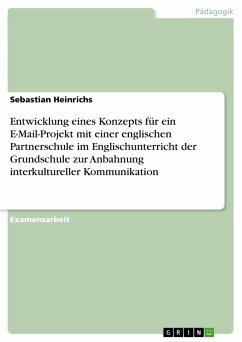
Hörverstehenstraining im Anfangsunterricht Englisch in der Grundschule
Theoretische Grundlagen und ihre Bedeutung für die Praxis

PAYBACK Punkte
0 °P sammeln!
Examensarbeit aus dem Jahr 2008 im Fachbereich Englisch - Pädagogik, Didaktik, Sprachwissenschaft, Note: 1,0, Johann Wolfgang Goethe-Universität Frankfurt am Main (Neuere Philologien - Institut für England und Amerkastudien), 50 Quellen im Literaturverzeichnis, Sprache: Deutsch, Abstract: Contrary to the inadequate assumption that listening is a passive operation,since it is among reading a receptive skill, listening or rather listeningcomprehension is proven to be a very active and complex process. Andmore than that; it is the key skill that is fundamental for first and foreignlanguage acq...
Examensarbeit aus dem Jahr 2008 im Fachbereich Englisch - Pädagogik, Didaktik, Sprachwissenschaft, Note: 1,0, Johann Wolfgang Goethe-Universität Frankfurt am Main (Neuere Philologien - Institut für England und Amerkastudien), 50 Quellen im Literaturverzeichnis, Sprache: Deutsch, Abstract: Contrary to the inadequate assumption that listening is a passive operation,
since it is among reading a receptive skill, listening or rather listening
comprehension is proven to be a very active and complex process. And
more than that; it is the key skill that is fundamental for first and foreign
language acquisition. That is why it should especially for English beginners
be the central skill to be taught in the ESL (English as a Second Language)
classroom at school.
Therefore this paper starts with a theoretical part including first of all, a
description of how listening comprehension works to show that it is a very
active process. Before the actual listening process, there is always a purposefor listening to the text and an expectation towards the text is developed.
This purpose could be taking part in communication or listening for
information, fun etc. The listening process itself consists of two parallel
processes that contain an interaction between text and listener, the bottom-up
process and the top-down process. During the bottom-up process the listener
absorbs the text and tries to understand what is said by using their already
acquainted phonological, lexical, syntactical and semantic knowledge. The
top-down process can be seen as an interpretation of the text, where the
listener uses not only their linguistic and cognitive knowledge, but also their
pragmatic, social-cultural knowledge and their assessment of the situational
context and the speakers. During these processes a number of listening
strategies that compensate possibly appearing problems are applied. These
problems can be caused by certain features of langua
since it is among reading a receptive skill, listening or rather listening
comprehension is proven to be a very active and complex process. And
more than that; it is the key skill that is fundamental for first and foreign
language acquisition. That is why it should especially for English beginners
be the central skill to be taught in the ESL (English as a Second Language)
classroom at school.
Therefore this paper starts with a theoretical part including first of all, a
description of how listening comprehension works to show that it is a very
active process. Before the actual listening process, there is always a purposefor listening to the text and an expectation towards the text is developed.
This purpose could be taking part in communication or listening for
information, fun etc. The listening process itself consists of two parallel
processes that contain an interaction between text and listener, the bottom-up
process and the top-down process. During the bottom-up process the listener
absorbs the text and tries to understand what is said by using their already
acquainted phonological, lexical, syntactical and semantic knowledge. The
top-down process can be seen as an interpretation of the text, where the
listener uses not only their linguistic and cognitive knowledge, but also their
pragmatic, social-cultural knowledge and their assessment of the situational
context and the speakers. During these processes a number of listening
strategies that compensate possibly appearing problems are applied. These
problems can be caused by certain features of langua













